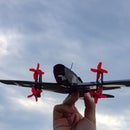Introduction: One Wheel Electric Skateboard
Hello
I had a hoverboard I haven't used for ages so my creative side took over and I decided to try making an electric one wheeled skateboard. I didn't want the electronics in the hoverboard to go to waste and wanted to do something creative with the time I had before a new semester of collage started. The idea came from seeing the Onewheel motorized skateboard which isn't commercialy available in Europe and I decided that was the perfect way to repurpose the components of my old hoverboard since the hoverboard isn't really made for longer and rougher rides in comparison to the Onewheel.
Here is how I did it (even though it can be done in a million and one ways) and what you'll need:
Step 1: Tools and Materials
For
materials I used:
-Parts from my hoverboard(whells, battery, mainboard, gyro board, leds...)
-Some steel metal extrusions (24x48mm and 24x24mm)
-metal sheet
-plywood
-plexiglass
-M3, M4 Screws and nuts
And for the tools I used 3D printer, drill, cutting tools and some sanding tools.
Step 2: Planning and Design
Firstly I designed everything digitally to make sure that the sizing was right for all the parts for easier assembly later on for which I used Fusion 360. I had to recreate the parts I already had from the hoverboard and the metal extrusions in Fusion and then add the parts I needed to print out and modify the design that I wanted for the skateboard so that it matched all those parts and lastly assemble it all together digitally.
Step 3: 3D Printing the Parts
I 3D prinetd out the parts that I designed in Fusion 360. Here are all the files I printed along with Fusion 360 file. After printing I painted some of the parts that are going to be visible on the board.
Step 4: Building a Frame
Cutting and drilling
Fusion 360 has a great feature to make real life 2D drawings of components I already had physically that I recreated digitally so that I could print it out on paper and glue it over the parts for more precise cutting and drilling.
Painting the metal extrusions
Firstly I covered the extrusions with primer. Secondly I sprayed on a few coats of anticorosive chrome paint. Lastly I put on a coat of trasparent matt spray.
Assembly of frame
Since it would be very difficult to hold a nut in place inside the metal extrusion while screwing I designed and printed out these parts (see the picture above) to put them into the extrusions to hold the nuts in place.
The frame is made out of four 163mm long extrusions wich are connected to two 525mm long extrusions with sixteen L shaped metal sheets and some M3 screws since welding wasn't an option for me.
Step 5: The Wheels
I'll be using both 350W wheels from the hoverboard as you could've already seen from the design. For mounting each wheel I reused four screws and casted metal part from hoverboard which is screwed with corresponding nuts already fitted in the frame.
Step 6: The Wiring
The wheel
wires were too short so they had to be extended and then were fitted trough the frame to the place where the mainboard is going to be placed. Battery wires were also too short so I made an extesion cable with male on the one side and female XT60 connector on the other which is also fitted trough the frame. I also added fuse casing with 10A car fuse for extra safety.
Step 7: Installing Electronics
Before installing them, electronics had to be modified a bit. Instead of two gyro boards I used only one so motor outputs are exactly the same. To enable that I just soldered two signal wires (blue and white) with the other two from the gyro board that I'm keeping, blue wire to blue and white wire to white. It's important to use gyro from the battery side. Also one motor had to be rewired to spin in the same direction as the other one. So blue and green motor wires and blue and yellow sensor wires were switched. I decided to activate the motors with a button that I step on, so I unsoldered the two photo interrupters, shorted one side and added PNP transistor on the other side. I used 2N3906 PNP transistor with emitter pin soldered to E and collector pin to +. One 220Ohm resistor connected from ground to base pin and one 220Ohm resistor from base pin to emitter pin. Lastly I connected the button with one side on 5V and other on base pin.
To mount electronics I cut out the board shape out of a metal sheet to be the same shape as the wooden part and screwed the electronics to it with some help of few 3d printed parts. I initially wanted to make a metal lid to protect the electronics but I decided to make it out of some plexiglass because I think it looks nicer and I can keep an eye on them at all time.
Step 8: The Board
Two wooden board parts were made out of some 10mm plywood. The button was placed on the wooden board on electronics side along with battery indicator LEDs. On the button I glued 40x40mm 3d printed platform for easier activation and wrapped some plastic around the platform. To finish the boards I glued some grip tape with wood glue and cut it to shape and screwed them to the frame with the iconic four screws on each side to give it that skateboard feel.
Step 9: The Battery
On the battery side I also cut the metal sheet with the wooden board and used a plastic piece from the hoverboard for mounting. Also I glued some packing material all around the battery section. The battery lid was also cut out from the metal sheet, bent it into shape and screwed to the frame with M4 screws.
Step 10: Finishing Touches
To finish it off I mounted some 3D printed parts that I've printed earlier like the end bumpers and shields around the wheel to deflect any debris. Also I added LED strips from the hoverboard to front and back bumpers by gluing the to some aluminum profiles to act as heatsink as they tend to get really hot. I also cut two windows for each end out of plexiglass to go over the LEDs and with that I was finished with the build.
Step 11: Riding the Electric Board
So to ride the board I have to put one leg on the battery side and then the other leg on the board with the button to activate it. By default, the motors will not turn while the board isn't level so I don't have to worry about it just flying away uncontrollably. Max speed of the board is the same as the hoverboards, so 15km/h and the board ended up weighing 10,9kg.

First Prize in the
Skateboard Contest















